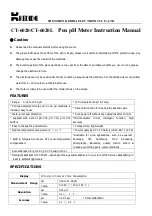
- -
12
3. “
SYSTEM PARAMETERS
”
3.1. “
Date and Time
” manages the instrument date and time setting. Use the
and
arrows to move the cursor, and the
and
arrows to edit the selected value. The
MENU key clears the seconds to synchronize them to the minute: Use the
and
arrows to set the current minute plus one, and as soon as that minute is reached
press MENU. This synchronizes the time to the second. Press ENTER to confirm, ESC
to exit without making changes.
3.2. “
Memory and Logging
” is composed of five sub-functions:
3.2.1. “
Log Interval
”: It sets the interval in seconds between two loggings. The interval
can be set from 0 to 999 seconds.
If the value 0 is set, the logging is
disabled.
Press LOG to start the logging, press LOG again to end.
3.2.2. “
Single Memory Mode
”: It selects the instrument memory management mode. It
applies only to the single record (MEM key): The continuous recording (LOG
key) stops when the available memory space is full.
By setting it to “
0
” you select the standard mode (normal): When the memory
is full, the logging stops; to carry out further recordings, you should download
the data, if necessary, and clear them.
By setting it to “
1
” you select the circular mode (“endless loop”): When the
memory is full, it starts to overwrite the oldest data. Recording is not
interrupted. The logging mode can be selected or modified only by the
administrator (see page
17
).
3.2.3. “
Memory on Print opt.
”:
If you select “
0
”, when using PRINT the current data is sent to the printer but
is not saved in the memory.
If you select “
1
”, when using PRINT the current data is sent to the printer and
also saved in the memory.
This parameter can be selected only by the administrator (see page
17
).
3.2.4. “
Clear Log
” allows to permanently clear all the data stored in the memory using
the LOG key. Press ENTER to confirm, ESC to exit without clearing the
memory.
3.2.5. “
Print Log
” sends all the data contained in the continuous memory to the device
connected to the serial port. The continuous recording data (using the LOG key)
are formatted across 80 columns:
They cannot be printed on the HD40.1 or
HD40.2 portable printer
. This command allows, for example, to send the data
to the HyperTerminal software. The DeltaLog11 software (vers. 2.0 and later)
manages the data transfer and the printing from the PC, and does not require
the use of this command.
3.3. “
RS232 Baud Rate
”. This function allows selection of the frequency used for the serial
RS232 communication with the PC. Values from 1200 to 38400 baud. Use the
and
arrows to select the parameter and confirm with ENTER.
The communication
between instrument and PC (or serial port printer) only works if the instrument
and PC or printer baud rates are the same
. If the USB connection is used this
parameter value is automatically set (please see the details on page
49
).
3.4. “
Electrode Serial Numbers
”. It identifies the serial numbers of the SICRAM probes
connected to the instrument inputs. These serial numbers are reported in the printouts
and stored data.
The SICRAM pH, conductivity and dissolved Oxygen probes report the “service hours”,
that is, the number of hours that the probe has been connected to the functioning
instrument. This parameter is saved in the SICRAM memory and cannot be modified.
3.5. “
System Reset
”: It is formed by two sub-functions:
3.5.1. “
Partial Reset
”: The partial reset restores the instrument functioning without
modifying the menu settings such as, Baud Rate, log interval, date and time…













































